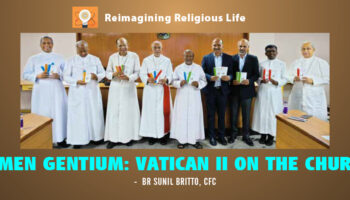Many of us will be making a retreat in April or May. Here are tips on making a retreat—based on my experience of making, preaching and directing retreats. Your experience will teach you more.
WHAT IS A RETREAT?
If you hold this page too lose to your face, you will not be able to read it. You cannot read it also if it is too far. To read correctly, you need the right distance.
Contemplation, or silence (or a retreat) happens when we look at our life from the right distance—to see how we live. All human beings need this. Otherwise, we simply carry on making the same mistakes. We do not grow up. We may also do much harm—to ourselves and to others.
There is no rule on how long a retreat should be, nor what type. An activist in a slum can be more contemplative and self-sacrificing than a lazy monk in a silent monastery. A mother of six active kids can have a deeper sense of God than a nun making a thirty-day retreat. It all depends on how genuine, and sincere, and loving we are, and how intensely we pursue paths of growth.
TYPES OF RETREATS
Preached: A preacher gives talks to the group. The group can be ten or ten thousand. Preached retreats can reach large groups. If the preacher is effective, the talks can enlighten, inspire and move people to improvement. Main danger: The retreatant may put the responsibility on the preacher, or think: I have heard the talks; I have made my retreat.
Charismatic retreats are one type of preached retreats.
Directed: The “real” director is the Holy Spirit. The retreatant spends time in prayer, especially with the Bible. S/he meets the director (possibly every day), especially to talk over the prayer experiences (and other personal matters). To be effective, the group must be small, and the director must be a good spiritual director.
Solitary: I can take time off, and make a retreat by myself. I do not need a group or a human guide. I may also meet someone for spiritual direction or confession.
TYPES OF RETREATANTS
The tone and contents of a retreat depend on the group. Seniors and teenagers have different needs. A parish group needs more talks than a group of priests or religious. A final profession group needs good spiritual direction and help with discernment.
HOW TO MAKE A RETREAT
Take responsibility for your inner journey. No one else can push you into a relationship with God, or make you good or happy. Or solve your personal problems for you. Know, too, that others are not really interested in your growth or happiness. If you want to be happy, and grow up, grab the chances you get, work at it, get help, change! A retreat is one such opportunity.
PRACTICAL TIPS
Keep silence. Read and mark your personal copy of the Bible. Spend at least four hours a day in personal prayer. Write what strikes you. Talk these points over with someone you trust and esteem. Make a meaningful confession, deciding to correct your major areas of sin, especially what does harm to others. Decide on at least one step that will help you to be a happier and more loving person.
CHECK THE FRUITS
Nothing produces results magically—neither our meals, nor our retreats. Check the fruits: “The Holy Spirit produces this kind of fruit in our lives: love, joy, peace, patience, kindness, goodness, faithfulness.” (Galatians 5:22).
Our goal is not simply making more retreats or even joining religious orders or prayer groups. All these are only means. Our aim is to become persons of love, joy, peace, patience, kindness, goodness and faithfulness. Our model is Jesus—and, secondly, anyone else who lives as He taught.
A retreat I get into with my heart and mind is one way of moving towards this goal.
– Fr. Joe Mannath SDB is the National Secretary of CRI and the editor of this magazine
To subscribe to the magazine Contact Us





